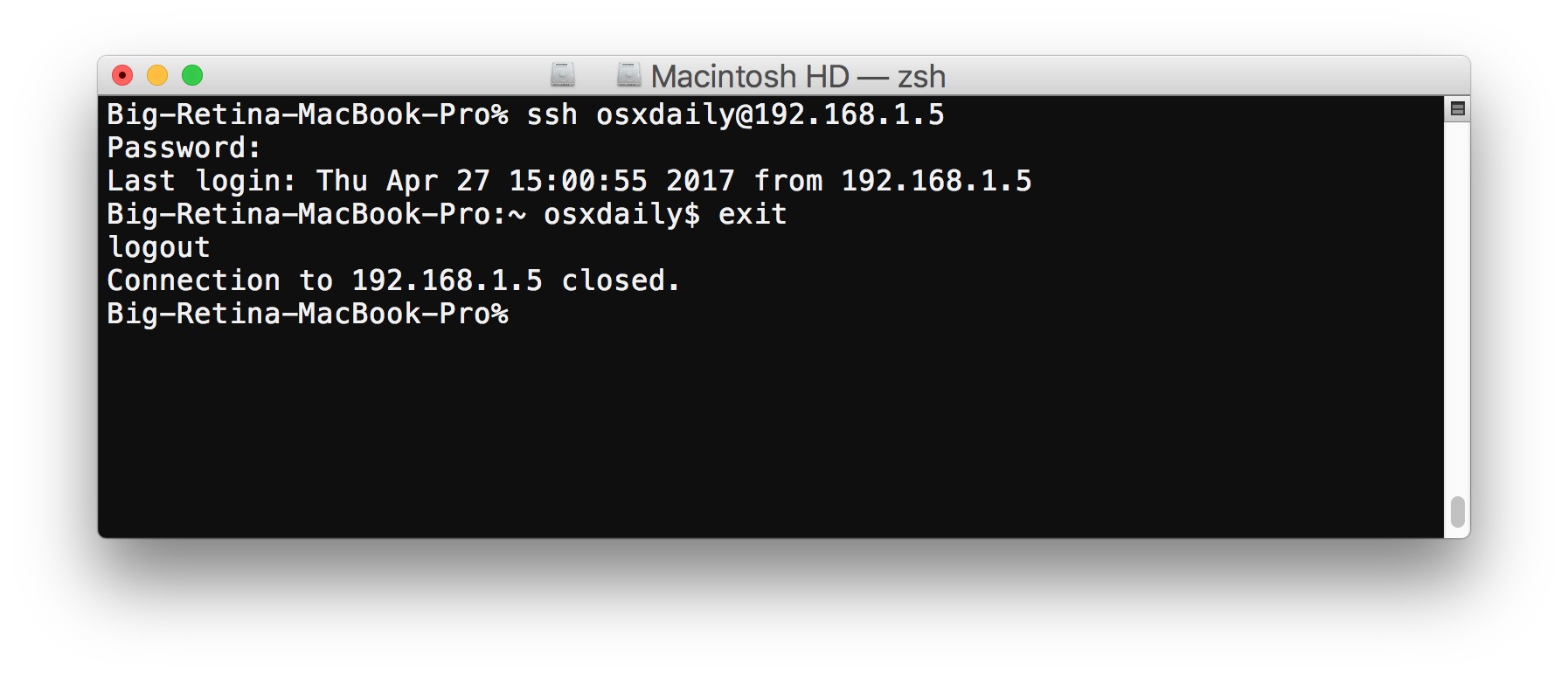SSH / config grep “host” This article introduces the method of MAC using shell (terminal) SSH to connect to remote server. For more content about shell SSH connection to remote server, please search the previous articles of developeppaer or continue to browse the related articles below. I hope you can support developeppaer more in the future! The SSH included with your Mac is a little different from the one which you would have installed on a Windows machine. On a Windows computer, you can either enter your username into a GUI, or use commands in the Command Prompt (which is the Windows version of the Mac Terminal) to log in. On Mac, we don’t have that GUI, so we’re going to log. Alternatives to SSH Terminal Emulator for Windows, Mac, Linux, Android, iPhone and more. Filter by license to discover only free or Open Source alternatives. This list contains a total of 25+ apps similar to SSH Terminal Emulator. List updated: 5/6/2019 8:59:00 PM. It’s the default terminal emulator that comes embedded in the Mac OS. It’s a wonderful.
Terminal For Mac Ssh Commands
WinOnMacs released Putty for Mac 9.1.1 for MacOS today. Putty 9.1.1 is a minor release, Please see the full change-log below for all the changes in this release.
Putty is one of the Best Terminal Emulators available today. It Supports different types of Network Protocols such as SSH, FTP, SCP, Telnet etc. In Windows it is used as SSH Client to connect to Your Linux server or for some other purpose But what will you do if you are on Mac? You might be thinking , Is there any Software like Putty for Mac Available? The answer is Yes! With the help of some other Software’s we can Use putty on MacOS although Putty is used widely on Windows Platform. Official Versions of Putty are available on Unix like Platforms, and now it’s widely available for Mac systems running OSX 10.12.6 or higher.
SSH is available by default in Mac and Linux or Unix. Although you can use terminal for SSH connections still there are some benefits in using Putty such as Other clients don’t keep connections alive whereas Putty does. Also it is cool to use Putty as your SSH client if you are doing some Amazon AWS, VMware ESXi or CISCO Stuffs, transferring files, managing files on a server or whatever.
The cost of Putty 9.1.1 is only $15.00. A Subscription plan is also available that comes with one year of free upgrades . Putty also comes with a standard 14-day money back guarantee.
Supported Protocols:

- Telnet
- FTP
- SFTP
- SSH
- SCP
About WinOnMacs:
There is a multitude of software developed only for the Windows operating system and even when software vendors port their applications to another platform, generally it lacks features that the Windows version contains. The only solution these developers face is to have access to both systems for testing which leads to increased infrastructure demands, and wasted project resources. Our goal is to have native ports of essential Windows tools and applications made available for MacOS users.
Version 9.1.1 New Features:
- macOS 10.14.5 Mojave support
- Minor bug fixes
We now use FastSpring as our preferred storefront, you can pay with Credit / Debit Cards, PayPal, Amazon payments, Wire Transfer etc. etc. This store is very secure, simple and fast.
Purchase Putty 9.1.1 now and have Telnet SSH FTP SCP on your Mac made easy!
To start, open up Terminal. To open Terminal, click on the Spotlight icon and type in the word “Terminal”. Click on the result Terminal (or hit Enter). Once you have opened the Terminal, you’ll be ready to log in to your SSH account.
The SSH included with your Mac is a little different from the one which you would have installed on a Windows machine. On a Windows computer, you can either enter your username into a GUI, or use commands in the Command Prompt (which is the Windows version of the Mac Terminal) to log in. On Mac, we don’t have that GUI, so we’re going to log in using a single command. This is actually a little quicker than using a GUI. Let’s get to it:
In the terminal, type:
ssh username@server.com
I’m using the username and the server that my professor at college assigned to me, so here’s what my login looks like:
Hit enter and you’ll be prompted for a password. The password is case-sensitive, naturally. Notice that the characters that you type don’t appear onscreen. SSH is more responsible about web security than I am. Once you have entered your password, hit enter again. If you’ve logged in successfully, you’ll see something like this:
Once again, notice the password isn’t shown at all. (In case you’re wondering, the blurred out bit has some info about your internet service provider which I’d rather not leave floating around the net, so that’s blurred out.) Assuming that everything went well, you should be all logged in and ready to go. Yay! Since we’re done for now, type “exit” to log off. I hope you enjoyed your first trip onto wherever you logged into!
This post was modified from a post originally published on Moshe Berman’s Blog on January 30, 2012. Moshe Berman is a student at Brooklyn College and an iPhone app Developer.
Terminal Mac Ssh Key

Mac Ssh Terminal Client
Filed under OS XTutorial
Ssh Terminal For Mac
Tagged: ssh, terminal, tutorial, vim
